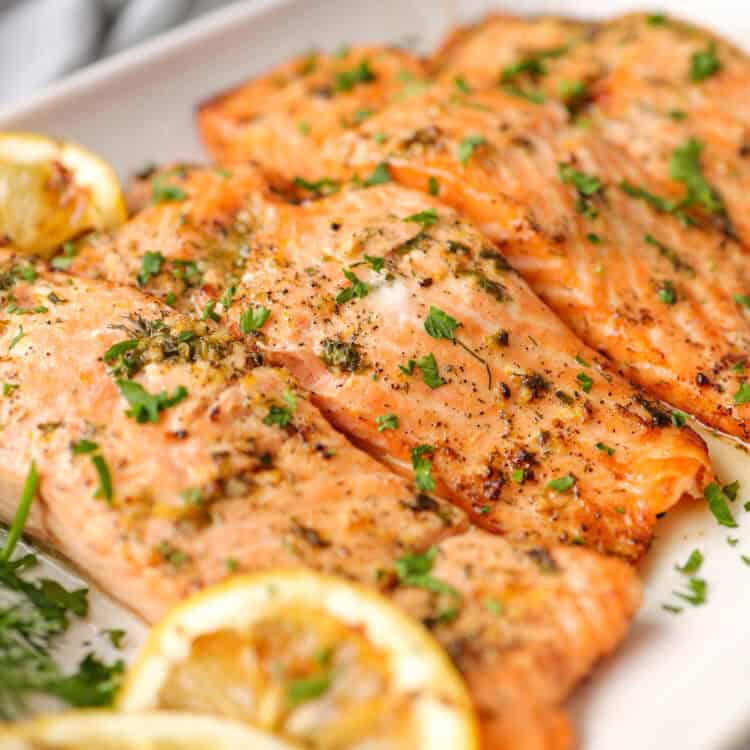Did you make this? Snap a photo and tag us on Instagram at @thrivinghome so we can see your creations and cheer you on!

Lemon Garlic Salmon (3 Ways)
Tender, flaky salmon meets the irresistible combo of butter, garlic, lemon, and fresh herbs. Cook it your favorite way: in the oven, air fryer, or on the grill.
Ingredients
- 2 tablespoons salted butter (sub: olive oil)
- 2 garlic cloves, minced (or 1 teaspoon pre-minced garlic)
- 3/4 teaspoon salt, plus more for serving
- 1/2 teaspoon black pepper, plus more for serving
- 1 tablespoon finely chopped fresh dill and/or parsley, plus more serving
- 1 lemon
- 4–6 (approximately 6-ounce) salmon fillets (skin-on or skinless)
Before You Begin! If you make this, please leave a review and rating letting us know how you liked this recipe! This helps our business thrive & continue providing free recipes.
Instructions
- Make Marinade: Place the butter in a small microwave-safe bowl and microwave in 10 second increments until melted. Add in the garlic cloves, salt, pepper, and fresh herbs. Zest the lemon using a microplane grater into the bowl (about 1 teaspoon). Cut the lemon in half. Squeeze the juice of one half into the bowl (about 1 tablespoon juice), straining out any seeds. Cut the other half into 4 wedges and set aside for serving. Stir the marinade together until well combined.
- Prep Salmon: Place the salmon skin side down on a lined sheet pan (or any dish/plate will work if you’re air frying or grilling). Pat them dry. Brush or spoon the marinade on top of each one generously and let it sit to marinate while you preheat your oven, air fryer, or grill. (Tip: Use any extra marinade on roasted asparagus or roasted broccoli.)
- Cook: Cook the salmon fillets using one of these methods, until internal temp reaches 125–130°F or until the thickest part flakes easily and is slightly translucent (see Cooking Notes):
- Oven: Preheat the oven to 400°F. Bake for 12-15 minutes.
- Air Fryer: Preheat the air fryer to 400°F. Spray the basket with cooking spray and place salmon skin-side down in a single layer, leaving a little space between them. Air fry for 5-7 minutes for thinner fillets and 8-10 minutes for thicker fillets (always start on the lower end and add more time as needed). No need to flip.
- Grill: Preheat grill to medium-high heat (400°F). Clean and grease the grates. Place fillets skin-side down on the grill. Close the lid and grill for 5-7 minutes without flipping. The salmon will naturally release from the grill when it’s ready to flip. Use a thin metal spatula to gently lift and flip. Grill another 2–3 minutes.
- Rest & Serve: Transfer salmon to a serving platter, cover with foil, and let it rest for 2–3 minutes (to finish cooking!). Serve warm with a squeeze of fresh lemon juice, perhaps more fresh herbs, and salt and pepper to taste.
Notes/Tips
How to Know When Salmon is Done:
- Internal Temp: Salmon is done at 125°F–130°F in the thickest part for best results. (USDA says 145°F, but salmon continues to cook while it rests, so its better to take it off earlier.)
- Flake Test: Use a fork to gently press into the thickest part of the salmon. It’s done if it flakes easily.
- Color Change: Raw salmon is translucent and usually deep pink. As it cooks, it turns opaque pink so keep an eye on the thickest part to make that color change.
- Texture: When pressing with your finger it should feel firm but still give a little to be done. If it’s super firm and dry-looking—it’s overcooked.
What is the white stuff that gets on top of salmon when cooking and how can I avoid it? The white stuff that appears on the top of salmon after cooking it for a while is called albumin (a protein that’s safe to eat but doesn’t look so appetizing). It typically oozes out at a temperature of 135°F or higher when it’s overcooked. So that’s why we suggest removing the salmon before it reaches that temperature.
How to avoid overcooking salmon:
- Undercook slightly, then rest: Salmon continues cooking a bit after you pull it off the heat so pull it off when it is at 125°F and let it rest a couple minutes.
- Cook skin-side down: This helps keeps moisture in.
- Use even thickness: If the filet is thick on one end and thin on the other, fold the thin end under to even out cooking time.
Find it online: https://thrivinghomeblog.com/lemon-garlic-salmon-3-ways/